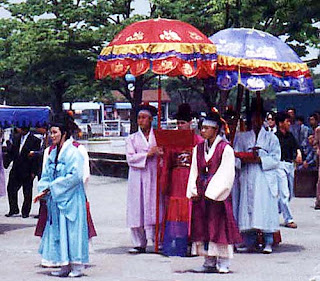
Marriage is a holy ceremony for almost everyone, especialy for the woman. There must be a special ritual and held in a special wedding halls. In Asia, many bride and the groom still hold a traditional way in the marriage ritual, such as pouring a tea for the eldest, and wears a traditional attire.
Korean Marriage Ritual
In Korea culture, the marriage between a man and woman represents the joining of two families, rather than the joining of two individuals.
As such, the event was often called Taerye (Great Ritual), and people from all over participated.
Steeped in traditional Confucian values, the ceremonies and events surrounding the actual marriage were long and elaborate, from the pairing of the couple to the rituals performed after the ceremony.
In the traditional Korean marriage, the elders of the prospective bride and bridegroom's families decided on all matters regarding the wedding, including the decision of whether or not to marry their son and daughter to each other.
Napchae (Date Setting) After confirming each family's decision to marry their son and daughter through a matchmaker, the familiy of the bridegroom-to-be sent the hour, day, month and year of his birth by the lunar calendar (known as the Four Pillars) to the family of the Korean bride-to-be and, in return, her family informed the family of the bridegroom-to-be the date of their wedding.
The family of the future bridegroom then sent a letter of marriage and wedding presents to the family of the future Korean bride. Napp'ae (Exchanging Valuables) Before the wedding, the groom's family sent presents to the Korean bride and her family in a box called a Ham. Additionally, the Hamjinabi (person who delivered the Ham) and a small group of close friends of the groom also took a pot of Bongch'i Deok (red bean rice cake) from the groom's family.
The bride's family would have a small party for the group, offering them food and drink for their efforts.
Arrange marriage in Korea
Jungme kyoron (중매 결혼) is an arranged marriage. Traditionally Koreans son bayo (손 봐요) or go on an arranged date or meeting with a potential marriage partner. Son bayo (손 봐요) literally means, to look at one’s hand. Son (손) means hand. Bayo = (look at, see). It dates back to the time when fortune tellers would “read” their clients’ palms to foretell of the future. In the same way, these arranged dates or meetings are used to determine whether the other person is suitable as a marriage partner. While jungme kyoron (중매 결혼) is an arranged marriage, it does not necessarily mean that one is forced to get married to a person he or she doesn’t like. There is considerable latitude over mate selection. Often people will go on several dates set up by a jungmejengi (중매쟁이) or matchmaker.
Although Koreans have kept several aspects of the traditional ceremony, most modern ceremonies resemble Western marriage ceremonies more than traditional Korean ones. However, many folk villages and museums across the country regularly perform ceremonies to keep the traditions alive.